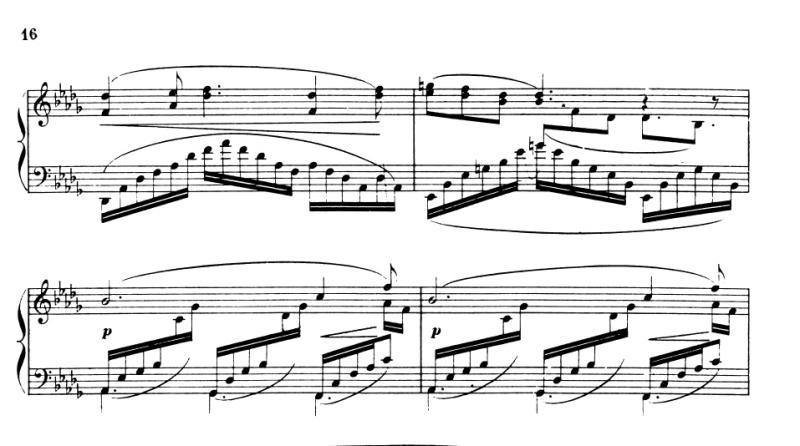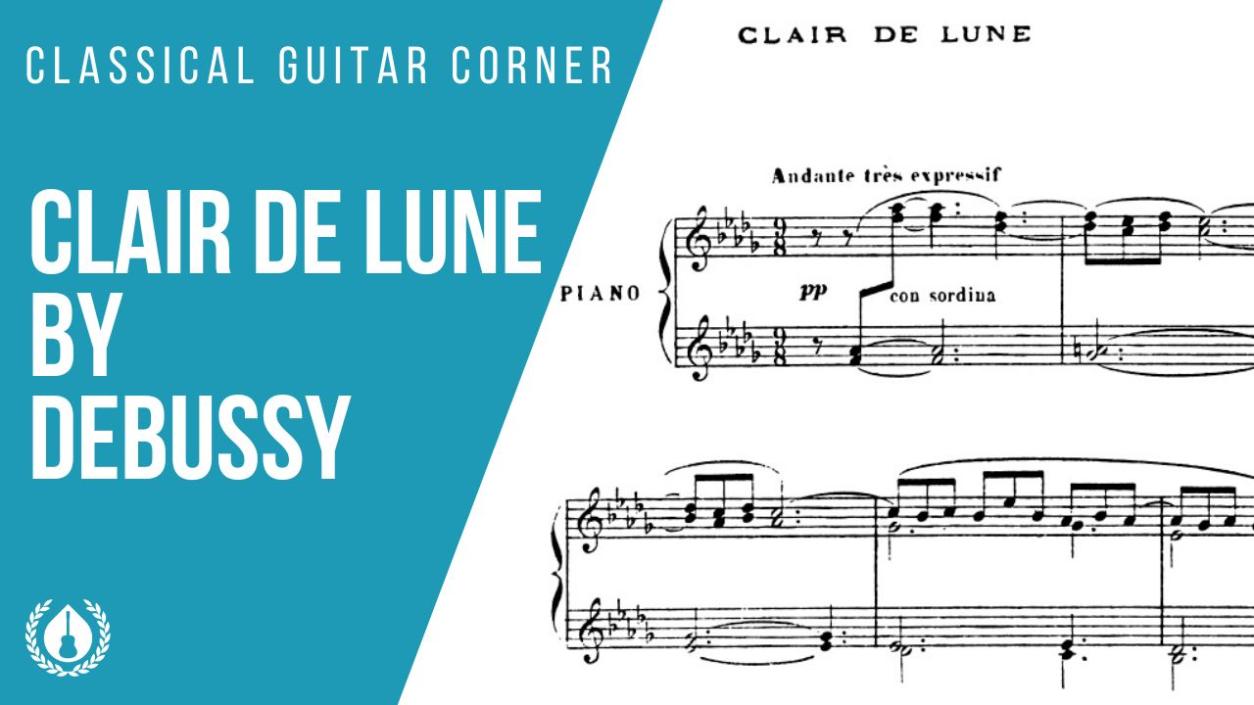Clair de Lune by Debussy for Classical Guitar
Clair de Lune by Debussy is one of the most famous piano pieces ever written. It appears in commercials, movies, and is the subject of countless YouTube videos. The piece has been arranged for all kinds of other instruments and instrument combinations, including guitar. In short, it may be one of the most well-known pieces of classical music ever written.
But do you know its story? We’ll introduce you to a little bit about the composer, the piece and its history, and what versions you should check out (especially on classical guitar).
Claude Debussy (1862 – 1918)
The French composer Achille Claude Debussy is usually included among the Impressionist composers of the late nineteenth and early twentieth century. However, Debussy was clear in a letter in 1908 that the term impressionism was “poorly used” by “imbeciles,” and that he was trying to do something “different.” But sometimes we don’t get to choose how history will remember or label us. And so Debussy is still widely known today as an “impressionist.” Other impressionists of the time would be Fauré and Ravel. But you may be more familiar with the Spanish nationalists, who also composed in an impressionist style: Isaac Albéniz and Enrique Granados. In another setting, the Mexican composer Manuel Maria Ponce skillfully utilized impressionist writing in some of his music.
Whatever his status as an impressionist, like painters and others included under that category, Debussy wrote many pieces that are reflective of nature (which he called “my religion”). The most significant are:
- Printemps
- Reflets dans l’eau
- La Mer
He wrote a great deal of important piano music, including the Suite Bergamasque, Two Arabesques, and Pour le Piano. However, some of his orchestral music is also monumental, especially the aforementioned La Mer, Images, and Nocturnes.
Clair de Lune
 Clair de Lune, which means moonlight in French, is the name of a poem written by Paul Verlaine in 1869. The images in Verlaine’s poem owe a great debt to a series of paintings by the French artist Jean-Antoine Watteau. Watteau painted in a style known as “fête galante” featuring figures in ball gowns and wearing masks and “bergamasques.” Central figures are characters of the divine commedia made popular in Bergamo, Italy. Verlaine had originally called his poem “Fêtes galantes” referencing “masques et bergamasques” all set under the “calme clair de lune de Watteau.” In the final published edition, he took out Watteau’s name and changed the poem’s name to “Clair de Lune.” (Fêtes galantes became the title of the collection of poems in which Clair de Lune was one part.)
Clair de Lune, which means moonlight in French, is the name of a poem written by Paul Verlaine in 1869. The images in Verlaine’s poem owe a great debt to a series of paintings by the French artist Jean-Antoine Watteau. Watteau painted in a style known as “fête galante” featuring figures in ball gowns and wearing masks and “bergamasques.” Central figures are characters of the divine commedia made popular in Bergamo, Italy. Verlaine had originally called his poem “Fêtes galantes” referencing “masques et bergamasques” all set under the “calme clair de lune de Watteau.” In the final published edition, he took out Watteau’s name and changed the poem’s name to “Clair de Lune.” (Fêtes galantes became the title of the collection of poems in which Clair de Lune was one part.)
Verlaine’s poem became the subject of Gabriel Fauré’s song of the same title included in his Two Songs, Op.46 along with pieces written by other French composers of the time. But, more significantly, it was also the title of the third movement of Claude Debussy’s Suite Bergamasque, L.75. As you will notice, the title of Debussy’s suite is also taken from Verlaine’s poem. In fact, Debussy wrote two other settings of the same title, Clair de Lune, for piano and voice.
Debussy’s Clair de Lune
The most memorable Clair de Lune is Debussy’s from the Suite Bergamasque. It is the third movement, in the key of Db Major, with a 9/8 time signature. The expression marking at the beginning of the piece is Andante très expressif. The music begins with an introductory section that is slow and airy building toward the middle section. The middle section of the piece has a melody on top with long notes broken up by a quicker arpeggio in sextuplets underneath.
 We are lucky that we can learn a little bit of how Debussy wanted the music to be played, from a written encounter with a student, Maurice Dumesnil. Dumesnil mentions that Debussy found his triplets to be “too strictly in time.” Thus the flow of the triplets should be more flexible. He also mentioned that both pedals should be depressed to allow the overtones to ring over one another. Regarding the arpeggios, Debussy was adamant: “The left-hand arpeggios should be fluid, mellow, drowned in pedal, as if played by a harp on a background of strings.”
We are lucky that we can learn a little bit of how Debussy wanted the music to be played, from a written encounter with a student, Maurice Dumesnil. Dumesnil mentions that Debussy found his triplets to be “too strictly in time.” Thus the flow of the triplets should be more flexible. He also mentioned that both pedals should be depressed to allow the overtones to ring over one another. Regarding the arpeggios, Debussy was adamant: “The left-hand arpeggios should be fluid, mellow, drowned in pedal, as if played by a harp on a background of strings.”
To this end, the guitar might be a nice instrument for this second section, especially with some harp-like campanella fingerings. However, it is quite challenging to maintain this flow on the guitar.
Next, let’s turn to some performances so you can hear the full piece in different settings.
Classical Guitar Arrangements and Performances
This masterpiece of Debussy is challenging to play on the piano. That means it will be even more challenging on the classical guitar. Not only can we fit fewer notes onto our instrument at once, but there are certain passages that are much more difficult to make flow. Let’s look at some of those challenges, and some of the performances/arrangements you should check out.
Key
The original key of Clair de Lune is Db Major. That’s a key we simply don’t play in on the guitar for one simple reason: all of the notes that make open strings on the guitar are flatted. Not having open strings makes things really challenging on the guitar. For more on this topic, see our blog on common keys on classical guitar.
For that reason, we need to change the key. We can do that in several ways: We could play it in C Major (and still get the original key by placing a capo on the first fret). Or we could move it up one half step to D Major, tuning the sixth string to Drop D. To make things even easier, we could move the key up to E Major, which gives us many open strings. Whatever key we use, there will always be compromises and new challenges that arise. Some arrangements use D Major but keep the sixth string tuned to E; others do use Drop D. There is a great arrangement by Eduardo Sainz de la Maza in E Major. Why does all this matter?
Open Strings and Campanella
As we learned from Dumesnil’s encounter with Debussy above, the first section of the piece should have the pedals “depressed to allow the overtones to ring over one another.” We can create this effect on classical guitar really nicely with campanella technique. This is a technique where you blend fretted notes with open-string notes. It creates a beautiful, ethereal harp-like texture. Here’s a great example of scales with campanella versus melodic fingering.
But to do so, we need open strings. So Db Major is a no-go. The key of any classical guitar arrangement of Clair de Lune is thus very important in creating that “overtone” resonance Debussy wants.
Flow
Another challenge with any classical guitar rendition of Clair de Lune is creating a performance with flow. At its root, the guitar is a percussion instrument. Not only is there a strong initial attack on guitar but also when we play a note, it quickly begins to die away. This makes the resonance demanded by the middle section of the piece, with flowing arpeggios, quite difficult. For this reason, guitar arrangements either succeed or crash and burn on how well they approach that section.
And of course, that section is not just flowing arpeggios, but a flowing arpeggio texture underneath a sailing melody above. And this is what creates so many complexities with guitar arrangements, because left-hand fingers must stay rooted holding melody notes while others move to create the arpeggios. There are some lackluster arrangements of the piece for classical guitar that solve this problem by simply removing the arpeggios altogether. Unfortunately, this makes for arrangements that carry nothing of the spirit and charm of the original.
Range
Even if we can solve the issues of key, resonance, and flow, another physical challenge for the guitar is its limited range. The piano can play a much wider range of notes that allow both for more depth and for a brighter sound. As a result, many classical guitar arrangements of Clair de Lune move sections of the music either up or down an octave in a way that breaks up the continuity of the range. This can be jarring for the listener.
Should we arrange this music for classical guitar?
And all of these challenges raise an important question: Should we, then, arrange this music for classical guitar? Are the above challenges insurmountable and fate us with arrangements that compromise too much of the original?
Andrés Segovia talked about the process of “transcribing” (by which he often meant arranging) as one that should only be undertaken if it improves the original in some way. And we can say quite clearly that the unassuming and gentle sound of the classical guitar is one that appeals to the spirit and ears of its listeners. The classical guitar’s sound is unique and one of the primary things that draw people toward it. So hearing pieces we are so fond of, like Clair de Lune, on classical guitar can be a delight. It is perhaps at least one reason why one of the most popular arrangements and performance on YouTube has over 10 million views:
At the end of the day, you, the listener must be the true judge of this question. Do you enjoy this music on classical guitar? Does this arrangement move you in the same way as the original?
Here’s another version that solves some of these challenges in different ways. What do you think?
Perhaps a better setting for the piece on classical guitar is for guitar duo. Here the two-guitar format resolves many of the challenges we discussed. The classic duo version is that of John Williams and Julian Bream:
Maybe we can’t answer this question definitively. The music is beautiful on the piano and clearly no less than 10 million people want to hear it played on classical guitar. Everyone will have their own opinion. For now, this is our favorite version:
***
We hope you enjoyed this look into the story and details of one of Western classical music’s best known pieces, “Clair de Lune” by Claude Debussy. While some have tried to arrange the music for classical guitar, with varying levels of success, the music is still much better known on its home instrument of the piano. What’s your favorite version of this masterpiece?


Leave A Comment